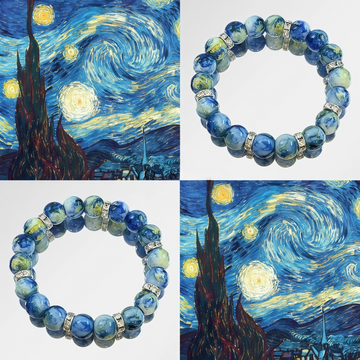Key aspects to note when cleaning stone bracelets
When cleaning stone bracelets, it is necessary to take into account the material characteristics, inlaying techniques and cleaning methods to avoid damaging the stone or structure. The following are the specific precautions:
First, the characteristics of stone and cleaning taboos
Hard stones (such as diamonds, rubies, sapphires)
Cleaning points: Use a neutral cleaner and a soft brush, or an ultrasonic cleaner (make sure it is firmly embedded).
Taboo: Avoid bleach and chlorine-containing cleaners (which can corrode metals).
Diamond bracelets can be cleaned with baby shampoo and distilled water. Use a cotton swab dipped in the cleaner to gently rotate the gaps.
Soft stones (such as pearls, corals, amber)
Cleaning tips: Wipe only with distilled water and a soft cloth, or dry with baby powder dipped in it.
Taboo: Do not use cleaning agents or ultrasonic cleaning (which may cause dissolution or cracking).
For example, a pearl necklace should wrap the pearls with silk and gently rub along the grain direction.
Jade (such as jadeite, Hetian jade)
Cleaning points: Neutral detergent + soft-bristled brush, or white tea oil maintenance (to enhance luster).
Taboo: Avoid high temperatures and collisions with hard objects (which can easily cause cracks).
After cleaning the jade bracelet, gently apply white tea oil to the surface, let it stand for 10 minutes and then wipe it clean.
Second, the inlay structure and cleaning details
Metal gap
Tools: Toothpicks wrapped in cotton cloth, professional jewelry tweezers.
Operation: Dip in neutral detergent and gently wipe the gaps. Avoid applying excessive force to prevent the inlay from loosening.
Carvings and patterns
Tool: Gently brush along the texture direction with a soft-bristled brush (such as a baby toothbrush).
For example, jade carved bracelets should be cleaned unidirectionally from the starting point to the end point of the pattern to prevent stains from remaining.
The bottom of the gemstone
Tool: Dip a cotton swab in the cleaning agent and rotate it to wipe the bottom of the inlaid gemstone.
Note: Avoid the cleaner flowing into the gaps between the gemstone and the metal to prevent corrosion.
Third, selection of cleaning tools and materials
Recommended tools
Soft-bristled brushes: baby toothbrushes (bristle diameter <0.1mm), horsehair brushes.
Cleaning cloth: 3M microfiber cloth, silk.
Cotton swab: Medical degreased cotton swab (free of impurities).
Recommended materials
Cleaning agents: Baby shampoo (pH 5.5-7.0), special jewelry cleaning agents (such as Connoisseurs).
Water: Distilled water (to prevent chlorine in tap water from corroding the stone).
Taboo tools and materials
Youdaoplaceholder0 Hard tools: metal tweezers, wire brush (for scratching stone).
Youdaoplaceholder0 Chemical cleaners: Bleach, 84 disinfectant (corrode stone surfaces).
Youdaoplaceholder0 Hot tools: Hair dryer hot setting (causes stone to crack or metal to deform).
Fourth, maintenance and storage after cleaning
Drying method
Tools: lint-free cloth, kitchen paper towels (press to absorb water to avoid scratches caused by wiping).
After cleaning, wrap the bracelet in a lint-free cloth and let it stand for 10 minutes until it dries naturally.
Maintenance materials
Stone: White tea oil (jade), baby oil (pearl).
Metal: Metal polishing cloth (for restoring luster).
Storage method
Tools: Individual jewelry box (scratch-resistant), desiccant (moisture-proof).
Example: Put the bracelet in a sealed box containing desiccant and avoid direct sunlight.
Fifth, handling of special circumstances
Stubborn stains
Method: Ultrasonic cleaning machine (when firmly set) or professional cleaning agent (such as Weiman jewelry cleaning agent).
Note: Ultrasonic cleaning is prohibited for soft stone.
Metal oxidation
Method: Metal polishing cloth + special cleaning agent (such as Tarn-X).
Example: If the silver inlay is partially oxidized, it can be gently wiped with a polishing cloth dipped in cleaner.
Crack or looseness
Handling: Stop cleaning immediately and send to a professional jewelry store for repair.
Sixth, suggestions on cleaning frequency
Daily: Wipe the surface with a soft cloth and distilled water to keep it dry.
Weekly: Clean the crevices with a soft-bristled brush and neutral detergent.
Monthly: Ultrasonic cleaning (for hard stones) or professional maintenance.
Summary: When cleaning stone bracelets, it is necessary to "tailor measures to the specific material". For hard stones, ultrasonic cleaning can be appropriately used, while for soft stones, chemical contact should be avoided throughout the process. Drying immediately after cleaning and regular maintenance can extend the service life of the bracelet. If you have any doubts about the cleaning method, it is recommended that you give priority to the service of a professional jewelry store.







